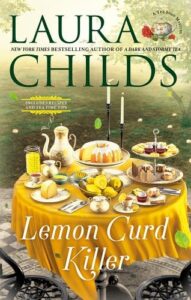When I talk to readers—at bookstores, libraries, and even tea rooms—the one think I’m always asked is where do I get my ideas and how do I find my inspiration? Do I get zapped in the head with the proverbial thunderbolt? Do I wait patiently until a big idea sparks the neurons inside my brain? Or is my every day choc-a-block filled with unbridled creativity?
Well, no. I actually spend most days trying to avoid writing. Here’s how it works: I get up at 8:00 AM and feed my dog (Lotus). Then I make breakfast for Dr. Bob (husband). I fast read the newspaper looking/hoping for ripped-from-the-headlines ideas, then watch Squawk Box on CNBC to see how lousy my investments are doing, all the while killing time so I don’t have to face my half-written manuscript.
Eventually, I capitulate and go to my office where I check emails and respond accordingly. I pay special attention to emails from Neiman Marcus and Nordstrom where I dream about buying $1200 leopard print Manolo heels. I check in with Facebook and try to post something fun and amusing (maybe ridiculously priced leopard heels?) I stall some more and then open my manuscript and read the chapter I wrote yesterday, fearful that it’s mostly pap and gibberish. At this point I’m always shocked to find that 60 to 80% is actually viable.
Am I inspired yet? Well, yes I am. And since I’m feeling much more confident about my work, I start pounding away at the keyboard, all the while spooling out workable ideas. Because the thing is, your imagination is a muscle that can be bent and stretched in so many delicious directions. And the more you use your imagination the more pliable and imaginative it becomes.
Ideas, good ideas, are literally everywhere. Remember my checking the newspaper this morning? There were oodles of ideas there owing to the fact that people are so dang crazy and weird. Even magazines offer snippets of ideas. I once read about a celebrity whose first job was as a ghost on a “ghost train.” Did I use the ghost train bit in one of my mysteries? Absolutely, I did. And when a local historical society sponsored a “cemetery crawl” at Halloween I snapped up that idea too. Ditto on an article I read about traveling a country “Quilt Trail” (only I turned my quilt trail into a murderous affair).
Think of all the authors who’ve snatched great ideas out of simple reality. Stephen King turned a rabid dog into Cujo. Michael Connelly took his days reporting the cop beat in LA and spun them into his Harry Bosch series. And Mary Higgins Clark was the first author to write about missing and abducted children in her breakout novel Where are the Children?”
When you find a spark of an idea, grab it, horde it, and run with it. Create your own concept file filled with notes and clippings. Do research and read articles that pertain to your subject. And once you’ve got a solid idea, start working on your all-important outline. Begin with a descriptive paragraph of your book (kind of like a TV show logline), then expand it into a few pages. See what you’re doing? You’re turning a basic idea into the beginnings of a plot. Maybe you can even take that plot to 15 or 20 pages and start to home in on the exact direction your novel should take.
Now go back and write your first chapter. This is where you go for broke. Your words and writing style need to grab your reader – scare , delight, or shock the hell out of them. Remember, you want to keep your reader coming back for more.
Now bang away at your novel as fast and as hard as you can. Don’t worry about finding the perfect words or sentence structures, just keep writing even if you’re not one hundred percent sure of where you’re going. Eventually, as you work your way through this, you’ll figure out how to create turning points, darkest before dawn scenes, plot twists, and surprise endings. You’ll find your way, I know you will.
When I have a good writing day—what I call falling down the rabbit hole—I often work for 7 or 8 hours straight until my eyes are bleary. And until I get a gentle nudge under my arm. Oh my, it’s my dog, Lotus. I’ve completely lost track of time and realize that she wants dinner (as does Dr. Bob). Looks like it’s quittin’ time for me.
As for you, dig around and find a nugget of an idea. Then polish it up until it’s nice and shiny and you’re ready to log some serious time at your computer. If you do all this (and add your own magic touch) you’ll for sure turn out a decent short story, essay, or even a novel.
One more thing. If you want to learn about writing from the masters, there are a few terrific books you should check out. My personal favorite is Stephen King on Writing from Scribner. Mr. King gives us a peek into how he got started and how he lays out a plot. I particularly loved the part where he says he simply “makes stuff up.” Ray Bradbury’s Zen in the Art of Writing (Bantam Books) shows you how to use what you see, hear, and live everyday as fodder for your creative writing. Then there’s Writing Mysteries: A Handbook by the Mystery Writers of America (Writers Digest Books). Here today’s top mystery writers share insights and ideas on writing. I mean, who wouldn’t want to take advice from Michael Connelly, Tony Hillerman, and Tess Gerritsen? Finally, there’s Writing the Breakout Novel by Donald Maas (Writers Digest Books). This powerhouse literary agent details the exact elements that all breakout novels share, then explains writing techniques such as creating larger-than-life characters and sustaining narrative tension.
Ready to get to work? Of course you are.
Best of luck with your writing!
***


















